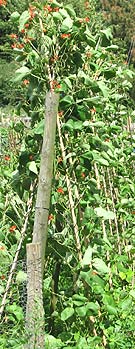Organic Methods of Pest Control
ORGANIC PEST CONTROL
The pesticides and fungicides used by organic gardeners are few but relatively safe, and many have been known for more than a century.
BACILLUS THURINGIENSIS
Bacillus thuringiensis - Based on an organism which normally lives in the nests of wild bees and of silk worms in Japan as a disease of waxmoth larvae.
It can be sprayed on most moth or butterfly caterpillars, but has no effect on sawflies, which are related to wasps and bees, depending for it to work by being eaten by the caterpillar.
The great benefit of Bacillus thuringiensis is that it is deadly to caterpillars yet completely safe for all other life in the garden.
It is important to spray the underside of leaves as the spores are destroyed by sunlight .
Bacillus thuringiensis is the best answer to the cabbage white caterpillar problem.
BURGUNDY MIXTURE
In the days when copper sulphate was easy to get hold of and freshly made with washing soda it was far stronger than the modern ready- made brands of today.
It was so strong that it should only be used on bush fruit or tree when these are without leaves in winter, or as a haulm killer after bad potato blight.
The ready- made Burgundy mixture is a safe preventative spray and general fungicide for potato blight on tomato and potatoes.
ELDER SPRAY
Kills aphids and small caterpillars . Is also a vegetable fungicide, used successfully against mildew on roses and blackspot. It is harmless to bees, ladybirds and their larvae , but not hoverfly larvae.
It is also safe for Anthocoris Nemorum, a very useful consumer of blackfly on your broad beans.
To make a solution, take half a kilo of elder leaves and smooth - barked green stems and put them into a large old saucepan with 6 pints of water.
Bring to the boil and simmer for half an hour, top up the water as it boils away. Strain it and use it cold and undiluted. It should keep for a couple of months.
The Elder, Sambucus Nigra, is grown easily from seed. Sow thinly in a corner and keep cutting back for a supply of young shoots , Or cut back a mature specimen after fruiting .
NICOTINE
To make the traditional nicotine soap wash it is best to buy a 2% solution ready mixed with soft soap.
Nicotine kills caterpillars and the tougher pests but it also kills bees, so use it in the evening when the bees are in bed , and it will have lost some of its strength by morning. It will be spent in less than 48 hours.
It does spare the eggs , adults and larvae of the two and seven spot ladybirds, hoverfly larvae, lacewing fly larvae and anthocorid bugs.
Nicotine is a poison, so be careful when using it . Do not drink it. Use gloves when spraying to keep it of your skin.
QUASSIA
This weak but Effective pesticide for aphids ,small caterpillars and mites comes in the form of chips and is from a West Indian tree Picrasma quassioides.
Quassia spares anthocorid bugs, lady-birds and their larvae, hoverfly larvae and bees.
To make this into a spray take 28g(1oz) of quassia chips and simmer in 1 litre of water for an hour, topping up the water as it boils away: then strain the clear yellow liquid, and stir in 28g (1oz) of soft soap or56g (2oz) of soap flakes, and dilute with three parts of water for sawfly caterpillars or mites and five parts water for aphids.
SOFT SOAP
Spares the lives of hoverflies, ladybirds, lacewing flies and their larvae, as well as anthocorid bugs and bees.
It is only strong enough though to kill caterpillars under25mm (1inch) long.
Soap flakes, washing up liquids, detergents and even washing up water
are all aphid killers, but not as effective as old fashioned soft soap.
Best made with rain water.
